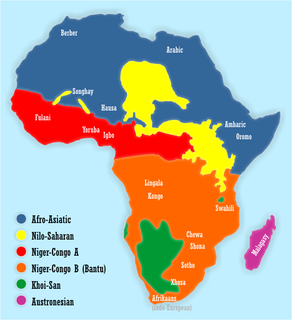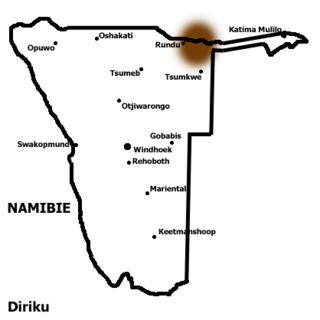Related Research Articles

The Bantu languages are a large family of languages spoken by the Bantu peoples in the southern half of Africa. They form the largest branch of the Southern Bantoid languages.
Kisuba, also known as Olusuba, is a Bantu language spoken by the Suba people of Kenya. The language features an extensive noun-classification system using prefixes that address gender and number. Suba clans are located on the eastern shore and islands of Lake Victoria in Kenya and Tanzania. They have formed alliances with neighboring clans, such as the Luo people, via intermarriages, and as a result a majority of Suba people are bilingual in Dholuo. The Suba religion has an ancient polytheistic history that includes writings of diverse, ancestral spirits. A recent revival of the Suba language and its culture has influenced the increasing number of native speakers each year.
Matuumbi, also known as Kimatuumbi and Kimatumbi, is a language spoken in Tanzania in the Kipatimu region of the Kilwa District, south of the Rufiji river. It is a Bantu language, P13 in Guthrie's classification. Kimatuumbi is closely related to the Ngindo, Rufiji and Ndengereko languages. It is spoken by about 70,000 people, according to the Ethnologue.
Tonga (Chitonga), also known as Zambezi, is a Bantu language primarily spoken by the Tonga people who live mainly in the Southern and Western provinces of Zambia, and in northern Zimbabwe, with a few in Mozambique. The language is also spoken by the Iwe, Toka and Leya people, and perhaps by the Kafwe Twa, as well as many bilingual Zambians and Zimbabweans. In Zambia Chitonga is taught in schools as first language in the whole of Southern Province, and parts of Lusaka and Central Provinces.
Tswa (Xitswa) is a South-Eastern Bantu language in Southern Mozambique. Its closest relatives are Ronga and Tsonga, the three forming the Tswa–Ronga family of languages.
Kwangali, or RuKwangali, is a Bantu language spoken by 85,000 people along the Kavango River in Namibia, where it is a national language, and in Angola. It is one of several Bantu languages of the Kavango which have click consonants; these are the dental clicks c and gc, along with prenasalization and aspiration.

Gciriku or Dciriku (Diriku) or Dirico, also known as Manyo or Rumanyo, is a Bantu language spoken by 305,000 people along the Okavango River in Namibia, Botswana and Angola. 24,000 people speak Gciriku in Angola, according to Ethnologue. It was first known in the west via the Vagciriku, who had migrated from the main Vamanyo area and spoke Rugciriku, a dialect of Rumanyo. The name Gciriku remains common in the literature, but within Namibia the name Rumanyo has been revived. The Mbogedu dialect is extinct; Maho (2009) lists it as a distinct language, and notes that the names 'Manyo' and 'Rumanyo' are inappropriate for it.
Rangi or Langi is a Bantu language of spoken by the Rangi people of Kondoa District in the Dodoma Region of Central Tanzania. Whilst the language is known as Rangi in English and Kirangi in the dominant Swahili spoken throughout the African Great Lakes, the self-referent term is Kilaangi.
The Zigula or Zigua language, Chizigua, is a Bantu language of Tanzania and Somalia, where it is known as Mushunguli (Mushungulu).
The Lomwe (Lowe) language, Elomwe, also known as Western Makua, is the fourth-largest language in Mozambique. It belongs with Makua in the group of distinctive Bantu languages in the northern part of the country: The Makhuwa-using area proper is separated by a large Lomwe-speaking area from the related eChuwabo, although eMakhuwa neighbours eChuwabo in a more coastal zone. To the south, the rather more distantly related Sena (ChiSena) should be assigned to a group with Nyanja and Chewa, while the distinct group which includes Yao, Makonde and Mwera is found to the north. Apart from the regional variations found within eMakhuwa proper, eLomwe uses ch where tt appears in eMakhuwa orthography: for instance eMakhuwa mirette ("remedy") corresponds to eLomwe mirecce, eMakhuwa murrutthu to eLomwe miruchu, eMakhuwa otthapa ("joy") to eLomwe ochapa.
Luyana (Luyaana), also known as Luyi, is a Bantu language spoken in Zambia and perhaps in small numbers in neighboring countries. It appears to be an divergent lineage of Bantu. It is spoken by the Luyana people, a subgroup of the Lozi people.
Yans (Yanzi) is a Bantu language spoken in the Democratic Republic of the Congo by the Bayanzi.
Taita is a Bantu language spoken in the Taita Hills of Kenya. It is closely related to the Chaga languages of Kenya and Tanzania. The Saghala variety is distinct enough to be considered a language separate from the Daw'ida and Kasigau dialects.
Kuvale is a Southern Bantu language spoken in Angola, in the middle of a large Umbundu -speaking area. It has traditionally been considered a dialect of Herero; however, Maho (2009) has moved it from Bantu Zone R.30 to Zone R.10, which includes Umbundu and a few smaller languages. Ngendelengo may be a distinct language.
Holoholo is a Bantu language of DR Congo and formerly in Tanzania spoken by the Holoholo people on either side of Lake Tanganyika. Classification is uncertain, but it may belong with the Takama group.
Binji is a Bantu language of eastern Democratic Republic of the Congo. Maho (2009) states that it is close to Songe, which is otherwise isolated within the Luban languages established by Ahmed (1995).
Simaa is a Bantu language of Zambia. It was assigned by Guthrie to Bantu group K.30, which Pfouts (2003) established as part of the Kavango–Southwest branch of Bantu. Though not specifically addressed, Simaa may be in that family as well.
Suba-Simbiti is a Bantu language of Tanzania. Suba-Simbiti is spoken by six groups in the Tarime region of Tanzania. This include Hacha, Kine, Sweta, Simbiti and Kiroba. The total number of speakers is in the region of 110,000.
Losengo (Lusengo) is a Bantu language spoken in the Democratic Republic of the Congo. It has had a significant effect on Lingala, the most important Bantu language in the two Congos.
Nzadi is a Bantu language spoken in the Democratic Republic of the Congo, "from Kwamuntu to Ilebo along the north side of the Kasai River in Bandundu Province." The number of speakers of Nzadi is not known, but is estimated to be in the thousands. The Nzadi language has three dialects, Ngiemba, Lensibun, and Ndzé Ntaa.
References
- ↑ ISO code request
- ↑ Jouni Filip Maho, 2009. New Updated Guthrie List Online